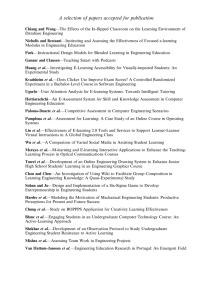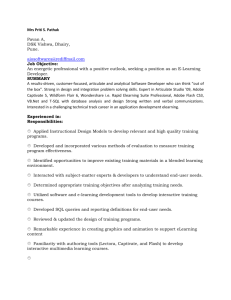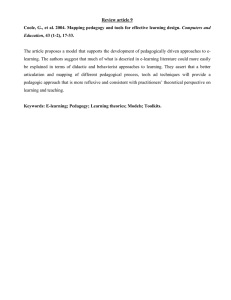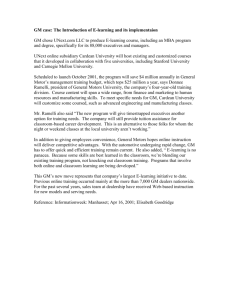INTRODUCTION OF RAPID E-LEARNING DEVELOPMENT WITHIN AN INTERNATIONAL GEOSPATIAL COMPANY
advertisement
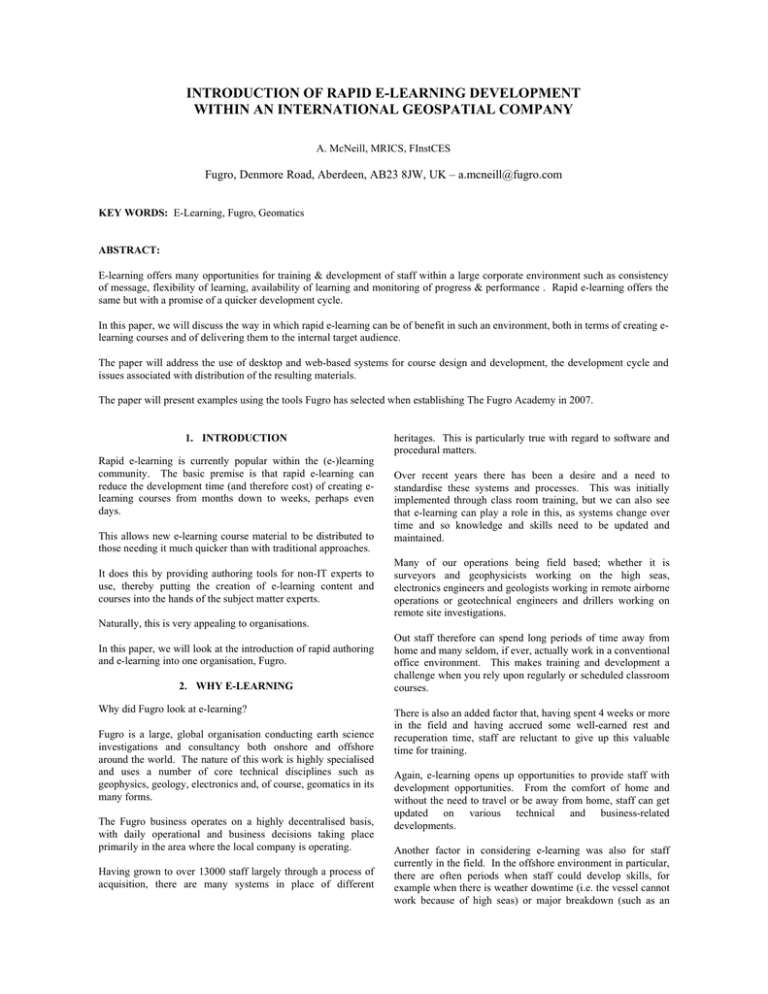
INTRODUCTION OF RAPID E-LEARNING DEVELOPMENT WITHIN AN INTERNATIONAL GEOSPATIAL COMPANY A. McNeill, MRICS, FInstCES Fugro, Denmore Road, Aberdeen, AB23 8JW, UK – a.mcneill@fugro.com KEY WORDS: E-Learning, Fugro, Geomatics ABSTRACT: E-learning offers many opportunities for training & development of staff within a large corporate environment such as consistency of message, flexibility of learning, availability of learning and monitoring of progress & performance . Rapid e-learning offers the same but with a promise of a quicker development cycle. In this paper, we will discuss the way in which rapid e-learning can be of benefit in such an environment, both in terms of creating elearning courses and of delivering them to the internal target audience. The paper will address the use of desktop and web-based systems for course design and development, the development cycle and issues associated with distribution of the resulting materials. The paper will present examples using the tools Fugro has selected when establishing The Fugro Academy in 2007. 1. INTRODUCTION Rapid e-learning is currently popular within the (e-)learning community. The basic premise is that rapid e-learning can reduce the development time (and therefore cost) of creating elearning courses from months down to weeks, perhaps even days. This allows new e-learning course material to be distributed to those needing it much quicker than with traditional approaches. It does this by providing authoring tools for non-IT experts to use, thereby putting the creation of e-learning content and courses into the hands of the subject matter experts. heritages. This is particularly true with regard to software and procedural matters. Over recent years there has been a desire and a need to standardise these systems and processes. This was initially implemented through class room training, but we can also see that e-learning can play a role in this, as systems change over time and so knowledge and skills need to be updated and maintained. Many of our operations being field based; whether it is surveyors and geophysicists working on the high seas, electronics engineers and geologists working in remote airborne operations or geotechnical engineers and drillers working on remote site investigations. Naturally, this is very appealing to organisations. In this paper, we will look at the introduction of rapid authoring and e-learning into one organisation, Fugro. 2. WHY E-LEARNING Why did Fugro look at e-learning? Fugro is a large, global organisation conducting earth science investigations and consultancy both onshore and offshore around the world. The nature of this work is highly specialised and uses a number of core technical disciplines such as geophysics, geology, electronics and, of course, geomatics in its many forms. The Fugro business operates on a highly decentralised basis, with daily operational and business decisions taking place primarily in the area where the local company is operating. Having grown to over 13000 staff largely through a process of acquisition, there are many systems in place of different Out staff therefore can spend long periods of time away from home and many seldom, if ever, actually work in a conventional office environment. This makes training and development a challenge when you rely upon regularly or scheduled classroom courses. There is also an added factor that, having spent 4 weeks or more in the field and having accrued some well-earned rest and recuperation time, staff are reluctant to give up this valuable time for training. Again, e-learning opens up opportunities to provide staff with development opportunities. From the comfort of home and without the need to travel or be away from home, staff can get updated on various technical and business-related developments. Another factor in considering e-learning was also for staff currently in the field. In the offshore environment in particular, there are often periods when staff could develop skills, for example when there is weather downtime (i.e. the vessel cannot work because of high seas) or major breakdown (such as an engine repair). At times like these, there are opportunities for learning, but of course they are unplanned and so getting a trainer on site or providing the training environment is logistically difficult. It would be ideal if the learning material was onboard, or available on-demand, when the learner had available time. 3. PRIOR E-LEARNING EXPERIENCE Fugro’s introduction to e-learning in 2007 was not our first elearning venture. As early as 2001, we had identified the potential that e-learning had to assist in developing staff skills whilst working remotely. An early exploration into e-learning had used an HTML Help Authoring package, RoboHelp, for creating e-learning material. Although the results produced were acceptable, it was found that development of the courses presented a number of issues including Managing source material with a desktop application Reviewing courses with multiple authors or reviewers Maintaining navigation between pages when restructuring courses Avoiding the look and feel of a Help file Limited interactivity and multimedia capability Protecting course content Trials with several e-learning or course authoring packages identified the steep learning curve, the understanding of complex software, and even programming skills, that would be needed. In addition, it seemed likely that a dedicated specialist team would be required to develop courses with these products. The various trials undertaken between 2001 and 2005 provided some lessons that we would apply in the future selection of an authoring package These included: Choosing the right tool for the job. Trying to use a tool designed for another purpose does not necessarily provide the best results Sophisticated e-learning may need complex tools to create it. These tools in turn may have significant learning needs in themselves and even specialist staff to operate them, with long development timescales Tools should be easy to use. It was not, and still is not, our intention to have a dedicated e-learning team. Our vision is to use the skills and knowledge of our existing trainers and subject matter experts to produce the majority of our e-learning, which means they need to quickly grasp the use of the authoring tool. 4. RAPID AUTHORING Given the dynamic nature of our business and the need to push a wide range of new information out to a global workforce, any approach that could reduce time and be simple to use had an appeal. We also recognised that much of our specialised knowledge was in the hands (or minds) of various technical experts (subject matter experts in e-learning terminology). By getting these people to create courses, we could capture and disseminate that experience to a wider community very easily. Rapid authoring seems to offer everything you’d every want: Fast development and creation of courses Short learning curve for users Simple and short training requirements Only a basic level of IT knowledge needed Acceptable (even good, arguably excellent) quality of products We signed up! 5. SELECTION OF TOOLS But first, we evaluated a number of different packages from the rapid authoring stable of products. As with any software selection, the range of options was overwhelming and, at times, difficult to separate the ‘need to have’ from the ‘nice to have’ The selection of an appropriate authoring tool (or tools) depended upon several criteria. Some of the main ones were: Easy to use Easy to install or access Easy to backup course material Content and output should be in a secure and ideally non-copyable format A variety of output formats should be supported Initially we hadn’t considered the deployment method too much; either desktop or web-based. At that time, we were experienced in the use of desktop software, but had little experience in web-based application software. However, after seeing a few products that operated on this basis, we began to appreciate the benefits of such a deployment for the enterprise-wide approach Fugro was taking, so narrowed our selection down to web-based products. The product we selected as our core authoring tool was Mohive’s e-Learning Publishing System or eLPS. In the next section, we’ll discuss some of the reasons for this. We also selected Adobe’s Captivate (previously called RoboDemo, a sister product to RoboHelp) for software simulation recording. This will also be discussed later. Why adopt a Rapid Authoring approach? 6. MOHIVE ELPS Having established The Fugro Academy in 2007 and identified that e-learning was of use to Fugro and could provide opportunities for staff training and development that were currently lacking, attention turned to the tools to be used. Mohive eLPS is a web-based enterprise-wide collaborative rapid authoring and publishing system. There were a number of reasons why we selected it. We’d become aware of rapid authoring tools a few years earlier and so had some appreciation of the benefits they offered. Mohive has a logical, integrated workflow model that makes it easy for an author to develop their e-learning course. The process goes from planning the e-learning module, to authoring the content, to quality control and review activities and finally to publishing. It can publish to SCORM, EXE, SWF and PDF, providing a high degree of flexibility for delivery of e-learning course products. Mohive operates on a template-based authoring approach. It has a wide range of standard templates that the author populates with the relevant details and then previews to see the learner’s view of it. Templates provide various types of interactions, multimedia displays and quiz/assessment tools. This makes it easy for authors to use, as generally no screen layout planning is necessary and consistency is achieved. The collaborative nature was known of when we selected Mohive but the power of this was not fully appreciated until we started to use the system for development. We knew we wanted our various specialists to work together on courses but the online nature of the package makes subject matter experts and quality review very simple to conduct. Course material authored in the morning can be reviewed and commented by personnel around the world within the same day. The review process can even extend into the field or offshore as long as a reasonable internet connection is available. Linked to the collaboration, the quality control facilities are probably the main functional elements that differentiated the Mohive product from the others we evaluated. Working in the oil and gas industry, quality control and quality assurance requirements are common place and being able to introduce this easily to our e-learning development process is a great advantage. With Mohive, the author can initiate a review cycle and monitor the various reviewers as they comment on the course. At the end of the review cycle, the author can then action the comments, leaving an audit trail of corrections and amendments. Subsequent review cycles can then include management for approval and adherence to corporate guidelines. 7. COURSE DEVELOPMENT PROCESS Although the Mohive workflow is a great benefit and makes the e-learning development process much simpler, we have realised that it is not enough in itself and needs supplemented. Rapid e-learning development relies not just on rapid authoring tools but also on other processes being carried out quicker than traditional systems development. By cutting down the timescales on each phase, the overall timescale gets compressed. Nevertheless, some of the traditional approaches like ADDIE (Analysis, Design, Development, Implementation, Evaluation) can be modified and applied. clear that this was not the case and more formal documentation guidelines were needed. In addition, as other media was incorporated such as Captivate files, the need for this increased. Variation style development. guides and standards are now under 8. ADOBE CAPTIVATE Adobe Captivate is the other component in our rapid authoring armoury. Captivate, previously known as RoboDemo, was initially developed by the same company who created RoboHelp where our e-learning journey began. Captivate is a desktop rapid authoring application that allows recording and playback of software demonstrations and simulations, as well being as a full authoring application in its own right. In common with Mohive, Captivate can publish to SCORM, EXE, SWF and PDF providing similar flexibility in distribution of the e-learning products. As internally-developed software applications are where a significant amount of classroom training effort is spent, Captivate provides the ability to take this and move it into the e-learning environment. Recording a simulation or demonstration takes no longer than performing the software function you are demonstrating. Annotating and enhancing this for e-learning delivery adds an overhead on top of this, but the process remains quick and is of course deliverable to a much wider audience on demand. The SWF output from Captivate can be embedded into Mohive so that the demonstrations or simulations can be integrated into a wider context. One of the main benefits of Captivate simulation capability is that you don’t actually need to have the application software installed on the learner’s PC. This overcomes issues with software licensing, operating systems, configuration and versioning issues, all factors that can plague classroom delivered training courses. The Captivate simulation can guide the learner through use of a new piece of software and make them familiar with it before they get exposed to it for real. It can also be used for competence assessment purposes. 9. E-LEARNING DISTRIBUTION This is the approach we are currently working on to put some structure to the process and add to the quality assurance of the products we create. This is a recent implementation and too early to say if it’s the correct or optimum approach. It has also been recognised that various standards and guidelines are also required if you want to maintain some consistency in style and appearance. Initial, we thought the template based approach in Mohive was adequate. However once multiple users got involved, it became Creation of your e-learning course is one thing. Getting it to your learners is another and some problems do exist in this area for us. In our infrastructure build-up, we also selected and implemented a Learning Management System, Enterprise Knowledge Platform (EKP) from NetDimensions. The architecture and configuration of EKP allow us to closely match in the virtual world, the Fugro organisation that exists in the real world. With limited central resources to manage an enterprise solution like this, local administrators were trained to manage local operations and staff. At a corporate level, a small team manage the system and provide support. The principle is simple, through internet delivery, staff anywhere in the world can login, view the courses available and sign up for them. If the course was an e-learning one they could also take it. For many of our users, this is exactly what happens. But introduce ships and aeroplanes, and people working remotely, and most especially limited internet bandwidth and problems develop. Although many of our vessels now have internet connections, the bandwidth is too low to stream or download media-rich material. On client vessels, our internet access may also be restricted. Even on high bandwidth vessels, much of the bandwidth is used for business and communications traffic. So we had to look for another solution for this group. This is the introduction of a mobile version of EKP. In principle, a learner with a laptop can log on to the system and, knowing that they will be without a connection for a period of time, sign up and download a series of courses to take offline. Upon returning to the modern world with internet access, they would log on again and the system would synchronise and update itself to reflect the learning and assessments they had completed whilst away. As this feature is still under development, we also needed to look at another solution Our third option is downloading courses to CD, DVD or USB and giving them to the staff physically. This is where the flexibility of Mohive and Captivate for publishing comes in. We can still author in our chosen environment, we simply publish to EXE or SWF as well as to SCORM. Unfortunately, we lose the detailed tracking information SCORM provides, but more importantly, learning and development can take place. Although not the optimum solution, we anticipate that this will be a temporary solution until the mobile version is available or wider bandwidth is possible. 10. ONGOING ISSUES Fugro is still early on in its journey into e-learning. Consequently, we are still defining and refining processes as we gain experience in many areas. We have a number of ongoing issues to address. Distribution is one that has already been mentioned. The development process is another. This is being tested currently through a series of pilot projects. As we run these pilots, we can look at the process we are using and evaluate whether it is correct or not. Already it has highlighted that we need documented processes, standards and guidelines to ensure consistency in products. Other improvements may also be identified. Development timescales are at this stage largely unknown. We know it can be rapid; we’ve produced courses in less than half a day and pushed them out to a global audience on the same day. But as courses get more complex, the time taken extends. The development processes we develop will also impact on timescales. We don’t want to burden the system down in process, but at the same time we do need a model to follow. Some more experience is needed to allow us to estimate the effort needed, so we can plan assignments and delivery schedules better Probably the biggest challenge is the area of instructional design. Most, if not all, of our course designers and authors have no formal instruction design training or education. Processes and approaches used for classroom training don’t necessarily apply for e-learning. There’s also a skill in deciding what makes an e-learning course engaging for a learner. Effectively, what does a good e-learning course look like? 11. SUMMARY Although still at an early stage, the introduction of rapid authoring and e-learning into Fugro has so far been successful. The concept has lived up to its claims and a number of courses have been created and distributed quickly and easily to a worldwide audience. The process is not as simple as initially thought though, and some effort is currently taking place to develop a development process and accompanying documentation such as procedures, guidelines and standards. Although introduction of such systems will inevitably slow down the process to an extent, in a corporate environment such measures are necessary to ensure consistency and quality of products. As authors and others involved in the process gain experience, this overhead may reduce. Instructional design is another area where some additional experience is needed. Evidence from several authors shows that course quality improves over time as the author gains experience in creating e-learning, but remains a potential problem area when tools are put into the hands of subject matter experts with little or no training experience.
